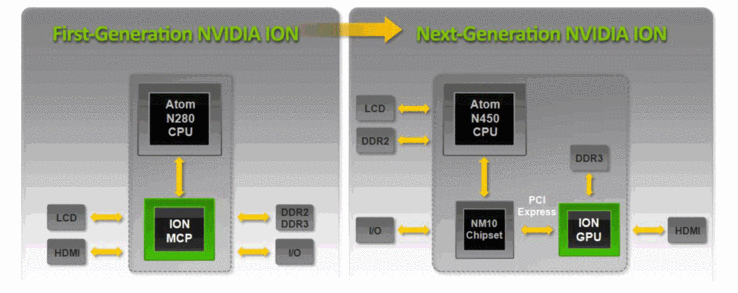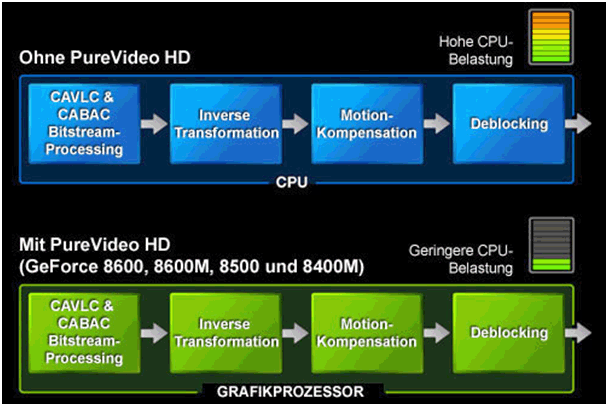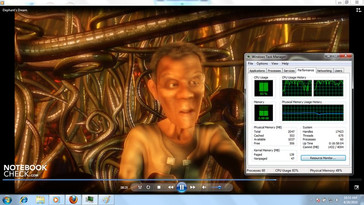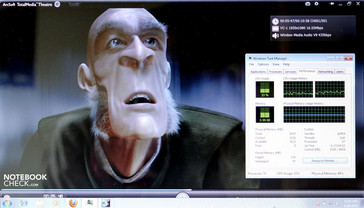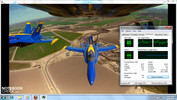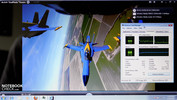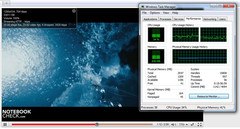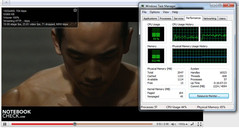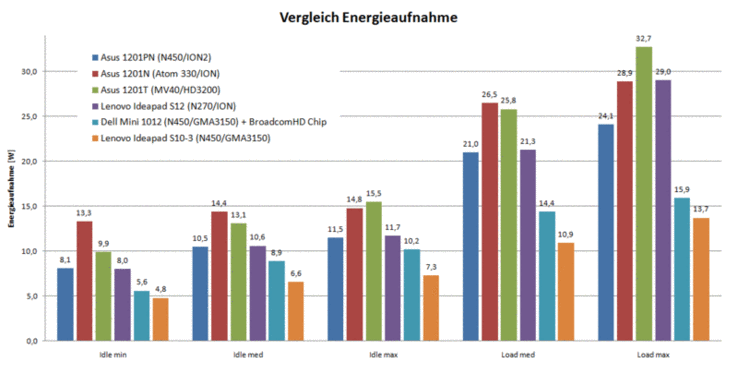Nvidia Next-Generation ION (ION2) in review
High DefinitION.
The first version of Ion already aimed at improving the performance of netbooks and enhancing their field of application. As Nvidia could no longer offer a chipset that supports the Pineview Intel Atom CPUs, the next generation of the ION platform comes with a dedicated graphics card.

We had a well-known netbook for our first tests of the new ION platform from Nvidia at our disposal, the Asus Eee 1201PN. Regarding case and related aspects please refer to the shortly reviewed Asus 1201N, which utilizes the first version of ION, is identical in construction and looks like the 1201PN on hand.
The netbook is equipped with an Intel Atom N450 CPU, 2 GB RAM, and a 250 GB hard drive. At the time of writing it is neither known when the laptop under review will be launched nor where it can be bought.
Technology
Contrary to the predecessor, the ION graphics solution inside the EeePC 1201PN is not a chipset graphics (GeForce 9400M in ION1). Instead, a dedicated graphics adapter based on the GT218 core is used. In 12” notebooks all of the 16 cores are activated, but, it is driven by a relatively low clock rate of just 475 MHz. So, the graphics chip can be compared to a highly downclocked GeForce G210M / GeForce G 305M and, likewise, it uses its own video memory (64 Bit memory bus, 512 MB DDR3). The later to appear 10" version of ION will feature only 8 shaders and an even lower core speed.
Besides featuring, as already mentioned above, dedicated video memory, the shaders were slightly revised compared to the first ION generation. However, due to limitations of the new Atom processors, ION2 is only connected via PCIe 1x. So, the performance is somewhat lower in theory, because the data transfer constitutes a bottleneck.
Thanks to 40nm lithograph the energy demand should be lower than with 9400M (ION 1), as long as the GMA 3150 does not always run in parallel.
Benchmarks
As usual, we start with a few generic benchmarks, which we ran with default settings in order to keep the results objectively comparable. However, consider that the results can not necessarily be directly interpreted as application or gaming performance in practice. Furthermore, new graphics cards are no longer that highly optimized for older 3DMark versions, which could also falsify the results.
Futuremark 3D Marks
In the last years the different releases of Futuremarks 3D Mark became reference benchmarks. Let's start with version 2001. The Asus 1201PN achieves 6882 points. Therewith, it can outpace nearly all notebooks with Intel GMA950, X3100, and 4500M (HD) expect of those with especially powerful CPUs. Netbooks based on Pinetrail (GMA3150) or older Atom N270/280/GMA950 combination achieve just about 2500-3000 points.
The Asus Eee 1201PN with ION2 already reaches about the level of mobile Office solutions with energy-saving CPU and dedicated graphics cards.
We continue with the 2003 release of 3D Mark. The impact of the GPU increases and the influence of the CPU falls in this newer version of the 3DMark benchmark. In favor of the Asus 1201 PN in the case.
It achieves 6569 points and can thus finally outperform various netbooks and entry-level office notebooks with integrated graphics card. For, example the Dell Latitude E6500 (P9500/NVS 160M), a wide-spread office laptop, ranks immediately behind the Asus. Graphics solutions about on par include, e.g., Geforce 8400M G, 9300M GS, Radeon X1600.
The first entry for ION1 can be found about hundred points below, and was recorded for the Apple Macbook with P8600 CPU (5759 points).
The ranking stays about the same in the 3DMark 2005. Accomplishing 3098 points the 1201PN is again on par with office notebooks of all brands equipped with dual-core CPUs and graphics cards like the Geforce 8400M GS or the NVS 140M. Exiting: Even Intel's new entry-level solution, i.e, Core i3-CPU (330M) and integrated Intel GMA HD graphics chip comes with 3000 points close to this level (Fujitsu Lifebook AH550, Toshiba Satellite Pro S500, mySN MB6).
The 3D Mark06 ranking, which gamers still like to refer to, is still hotly contested. The Asus 1201PN is again able to deliver a decent result of 1963 points (1280x1024 pixel). In the same range you'll also find Intel's GMA HD graphics chip combined with current Core processors up to the powerful i7-620M.
Netbooks with ION1 inside (Samsung N510, Asus 1201N) achieve about 1000 points less and are therefore nearly 50% slower than the new Intel N450 / ION2 combination.
The newest 3DMark release is called Vantage and aims to even show limits of gaming bolides. Although 1368 points do not seem much, the result can actually convince compared to other entries in our database. Intel's GMA HD can not exceed 400 points, even not if combined with powerful CPUs. Still, the Dell Inspiron 13z (SU7300/G105M) or the Acer Aspire 5738DG (P7450/HD4570) perform slightly better. However, the later can already be called a multimedia starter.
| 3DMark 2001SE Standard | 6882 points | |
| 3DMark 03 Standard | 6569 points | |
| 3DMark 05 Standard | 3098 points | |
| 3DMark 06 Standard Score | 1963 points | |
| 3DMark Vantage P Result | 696 points | |
Help | ||
Graphic cards with similar benchmark results hint on the potential of the next generation ION solution (for 12" netbooks). While the result is still rather meager in the 3DMark 2001, the ION2 graphics solution does better the newer the release and finally achieves a respectable result of about 700 points in the 3DMark Vantage. At the same level you'll also find entry-level multimedia notebooks like the Acer Aspire 5738DG (P7450/HD4570).
It is to be expected that ION2 even performs clearly better if combined with a powerful dual-core CPU and can clearly leave ION1 and Intel's GMA HD graphic solution behind.
Gaming
Except of the benchmark tests above, we are especially interested in the actual performance in computer games in practice. Even more, because Nvidia announce that ION2 is compatible with "today's most popular mainstream games". It is out of question that this will not include current demanding games like Battlefield Bad Company 2. Rather, ION2 should be able to cope with various Internet-based RTS (real-time strategy) and MMO (massively multiplayer online), and Arcade games.
We checked the playability of some of the possible titles. The included videos should give an impression of the game flow.
World of Warcraft (WoW)
We start with Wow, probably one of the most popular games. With 10 million users the blizzard still enjoys great popularity. We built a new character for our test and moved around in the vicinity of the starting point (humans).
At a resolution of 800x600 Pixel and lowest possible detail settings, the observed frame rate fluctuates between 31 and 56 fps (Schnitt 44 fps). Subjectively, the game proved to be smoothly playable. Raising the resolution to 1024x768 Pixel and the details to medium (all option on), the frame rate dropped to 16-35 frames per second (27 fps in average). Subjectively the game studdered along.
If you compare the results to our database, the Asus 1201PN can outstrip weak systems with GMA 4500M graphics. E.g, the Acer 3810T (SU3500/4500M) just achieved about 32.8 fps in average at low settings. The older netbook platform is clearly defeated, e.g., the Aspire One 531 (N280/GMA950) with 16.3 fps and also the Intel PineTrail Plattform ranks lower.
| World of Warcraft | |||
| Resolution | Settings | Value | |
| 1024x768 | med | 27 fps | |
| 800x600 | low, 0xAA, 0xAF | 44 fps | |
A resolution of 1024x768 Pixel and low details were used for this video. Wow looks adequately good with these settings and the performance of 21-58 fps (32 fps in average) can be classified as “playable with restrictions”.
Anno 1404
Although Anno is not necessarily a multimedia classic, it is very popular. A number of tests with different notebooks have already proved that a generally easy-going economic simulation, can yet be quite demanding.
So, we consciously selected low settings at a resolution of 1024x768 Pixel. Although the game looks less nice, it is still exciting to puzzle out perfect production chains.
A frame rate between 2-28 frames is indeed disillusioning. Even the average of 13 fps cannot change this. If you do not mind that the game often studders during scrolling, it can be played to some extent.
In comparison it gets obvious that the Asus 1201PN with ION2 lags behind already testes systems with ION. E.g, the Ideapad S12 and the Samsung N510 are slightly better than the Asus. Again systems with GMA 4500MHD graphics perform worse. Common netbooks with GMA950 or GMA3150 fail to run Anno 1404 at all.
| Anno 1404 | |||
| Resolution | Settings | Value | |
| 1024x768 | low, 0AA, 0AF | 13 fps | |
The following video ran at the settings mentioned above
The Sims 3
As Sims 3 is not that demanding, the new ION 2 solution should be able to run the popular life simulation. The Asus 1201PN achieved 10-38 frames at a resolution of 800x600 pixels and low details. The frame rate clearly falls if the details are raised to medium, all options are switched on, and the resolution is increased to 1024x768 pixel: 1-33 fps, 17 fps in average. We personally felt that the game flow became too jerky to enjoy the game with these settings. However, the 8-35 fps at 1024x768 and low details was suffice for calling the game playable (as can be seen in the following video).
Comparing the results at low settings, the 1201PN is outpaced by various office notebooks with Intel GMA 4500M(HD) graphics, which indeed use a clearly more powerful CPUs. Again the Samsung N510 ranks higher. Interestingly, the rank inverts as soon as the resolution is increased to 1024x768 Pixel. Here, the 1201PN is able to perform better than various Office notebooks and the Samsung N510 (16 versus 10 fps).
| Sims 3 | |||
| Resolution | Settings | Value | |
| 1024x768 | med / all on | 16 fps | |
| 800x600 | low / off | 23 fps | |
A resolution of 1024x768 pixel and low graphics details were used for the video.
Battlefield Heroes
Of course a genuine shooter should not miss in our gaming suite. We choose Battlefield Heroes, which is available online for free. In the test with low graphics settings and a resolution of 800x600 fps (Fullscreen) we observed 9-49 frames per second and an average of 16 fps. Subjectively, the performance was to low to be able to play with others online.
Reducing the detail level from “low” to “super low”, resulted, depending on the selected game world, in a higher performance of 19-27 fps in average. Sporadically this was sufficient to collect some Kills, however, studdering sometimes had a big impact on our score. The configuration for the test is so to say the lowest possible setting. If the CPU were slightly more powerful, you would surely gain more latitude.
The following video was recorded at 800x600 pixel resolution and low details.
Trackmania Nations
Turning to the Arcarde Racer genre we covered a variety of games that could be possibly played on the Asus 1201PN. Trackmania ran at 640x480 Pixel (AF: biliniar) resolution and minimal settings at 26 fps in average and subjectively appeared to run sufficiently smooth for the player to be competitive in a race. Raising the graphics demands to high, 1024x768 and 4xAF had fatal effects on the performance: the frame rate dropped to 15 fps.
The outcome of the comparison is similar to Sims 3. While the Asus 1201PN lines up behind, it can outpace some notebooks with energy-saving CPUs and Intel 4500M graphics. This is indeed an evidence for highly limiting CPU, in this case an Atom N450 from Intel.
| Trackmania Nations Forever | |||
| Resolution | Settings | Value | |
| 1024x768 | High Quality, 0xAA, 4xAF | 15 fps | |
| 640x480 | Minimum Quality, 0xAA, BilinearAF | 26 fps | |
The video shows the game in the native resolution of 1366x768 pixel and graphics presets at "faster".
HD Video Performance
After the detailed gaming tests you may conclude that the main purpose of ION is a better performance in computer games. This not exactly the case. First and foremost it aims to improve the HD-Video-capabilities. In this way also netbooks should be able to smoothly play online and offline HD-content.
Thanks to PureVideo HD with the Video Processor 4 the graphics card can completely take over the decoding of HD videos in H.264, VC-1, MPEG-2, MPEG-4 ASP for the entire pipeline (CAVLC/CABAC Bitstream Processing, Inverse Transformation, Motion Compensation, Deblocking).
The benefit of PureVideo HD can be impressively observed, when watching the VC-1 encoded 1080p video “Elephant's Dream”. If we play the filmlet under the free VLC (Video LAN Client), whose current version does not support hardware acceleration, the user sees only single pictures and hears distorted sound. With the Windows Media Player 12, the video is reasonably smooth, and the system load reached 70-90%. With the pre-installed ArcSoft Total Media Theatre Software the video could be played absolutely smooth at just 20-30% CPU load. Subjectively the playback was not absolutely smooth with the Mediaplayer and clearly smoother with ArcSoft.
The same effect could also be observed with both other test videos, “Big Buck Bunny" (1080p, h.264) and "The Magic of Flight" (1080p, wmf). Both videos ran also with Windows Media Player smooth, but, the CPU load was clearly higher than under AcrSoft Total Media Theatre. Again the VLC 1.0.5 was a miserable failure. Thereby, the sound was accompanied by infrequently changing and blurred pictures.
Thanks to ION the Asus 1201PN also features a digital HDMI port, which allows connecting external screens. We tested the video playback of our 1080p HD-videos on an external Dell 2408 Wfp display at full resolution. As expected, the result does not differ from the values observed with the internal 1366x768 pixel display.
You Tube
This is what the average netbook user will likely do most frequently: play HD-material via You Tube. It's crucial to have an up-to-date version of Adobe Flash, at least version 10.1 installed. Not until this a GPU-based processing of video clips, which unloads the Atom CPU, is possible.
We selected the trailer of “Ninja Assasins”, which is available in different qualities, for our tests (as it supports displaying fps and bitrate information). In window mode, we could enjoy a smooth video at constantly 23-24 pictures per second. In fullscreen mode the frame rate dropped to 20-24 fps in the 720p test and was subjectively not exactly as smooth as in a window.
This gets even more apparent with the 1080p video, with which the frame rates fell to 18-20 fps, and already made watching somewhat uncomfortable.
Regardless of the quality the CPU load stayed between 30-40%.
According to Nvidia ION2 should also be able to handle Blu-Ray videos. Because we did not have an external Blu-Ray drive on hand, we could not verify this. But, the test videos in VC-1 and H.264 prove that there should be sufficient reserve capacities for a smooth Blu-Ray playback.
Video playback in comparison
Netbooks which are only equipped with GMA 3150 can only utilize the decoding capabilities of the weak Atom CPU. So, H.264 encoded videos with more than 720p can not be handled and full HD videos won't run smoothly. Flash Videos as on Youtube can only run smoothly in SD (see our review of the Asus Eee PC 1005PE).
Besides ION, also Broadcom offers a solution which enables netbooks to play HD videos smoothly. The Crystal HD is an additional chip and not a graphics card. It just unloads the CPU at video decoding. So, netbooks with Broadcom HD acceleration do not feature an HDMI out or improved gaming capabilities. During our test of a Dell Mini 1012 with Broadcom Crystal HD Chip we could smoothly play 1080p Videos under the Windows Media Player. However, the Flash 10.1 Beta did not yet support the Broadcom Chip at that time. Since release Beta 3, it is supported and, so, even Flash videos in 720p should run smoothly.
The prices of notebooks with Intel's CULV platform with Celeron CPU and GMA 4500MHD fell to netbook level in the meanwhile and therefore could also be counted as competitors. E.g., the Acer Aspire One 752 with Celeron M 743 und GMA 4500MHD could smoothly run HD videos under WMP 12. Just, the VC-1 coded Elephant's Dream slightly jerked along with high CPU load. Thanks to the Arksoft solution, ION has a small advantage here. But, the GMA 4500MHD clearly looses at Flash videos and could not even play 720p coded videos in Youtube smoothly. Faster dual-core processors in CULV laptops would help, but, the price level can not be hold.
Even the AMD solution in the netbook range, i.e, MV-40 Single-Core-CPU and HD3200 video card allows a smooth playback of HD videos. However, the HD 3200 has to surrender when playing Flash videos above 720p. Just like the Intel solution, manufacturer's can built-in an HDMI port with AMD's solution.
Compared to ION1, ION2 netbooks use the Video Processor 4, which implements some small improvements (MPEG-4 ASP support and no longer exceptions at uncommon resolutions; see PureVideo HD in Wikipedia).
To summarize, ION 2 appears to be the best solution in the cheap range when it comes to smooth HD video playback at the time of writing. However, the competitors, e.g., Intel's CULV, AMD, and Broadcom only show weaknesses with Flash.
Energy Consumption
Higher performance nearly always leads to more energy consumption. A possiblity to optimize both would by the new Optimus technology from Nvidia. In general the next generation ION would be ready for Optimus. But, the manufacturer of a devices has to decide whether he also implements it. Asus did not utilize Optimus in the Eee 1201PN, because Optimus and the GMA 3150 do not work together up to now. Apparently, it is difficult to combine the DirectX 9 capable GMA 3150 and the DirectX 10 graphics card for Nvidia.
As usual, we checked the energy demand of our test system under different settings. Without load, the energy demand of the 1201PN is, depending on the active energy profile, the display brightness and the state of the communication modules between 8.1 and 11.5 Watt.
Under load we recorded an average wattage of 21 W and a maximum of 24.1 Watt.
| Off / Standby | |
| Idle | |
| Load |
|
Key:
min: | |
The achievable battery life of the Asus 1201PN with 47Wh ranges between just above three hours under load and a maximum of 6.5 in the best case (energy saving profile, min. display brightness, deactivated communication modules). Browsing the Internet via WLAN, you can count on a battery life of about five hours. On its own, this is not too bad, but, typical Pinetrail netbooks can do much better. Following, we compare different devices in regards of their energy demand. Of course different displays, RAM etc. will also have an impact. Nevertheless, a trend is evident.
Compared to other current devices of the netbook range, the Asus 1201PN is mid-range in regards of energy demand. The Asus 1201N, equipped with ION1 and an Intel Atom 330 CPU (dual-core) clearly needs more energy than the new Eee 1201. The competition from AMD used inside the Eee 1201T (MV40 CPU / ATI HD3200 Grafik) also needs more power.
Compared to the Ideapad S12 from Lenovo (same display size), which is equipped with Atom N270 CPU and ION1 graphics solution, there is hardly a difference.
However, Intel's Pinetrail platform alone needs clearly less energy. For example, the Ideapad S10-3 with N450 CPU and GMA 3150 needs a minimum of 5 W and does not exceed 14 Watts under load.
It gets hard for the Asus 1201PN on hand when compared to the Dell 1012, which is based on Pinetrail and features the Crystal HD chip. Just like the ION2 technology, the later also allows 720p and 1080p HD-playback, but, the energy demand of the Dell netbook is clearly lower than of the Asus 1201PN.
The additional energy demand can finally be explained by higher performance reserves, e.g., for computer games. As soon as Optimus is available for ION2 and implemented, the energy consumption in idle mode should shrink to the level of Atom netbooks without additional chip and the Broadcom competitor could be beaten in this aspect. Still the power consumption under load will stay the same (or even slightly higher as the GMA 3150 is running too).
Verdict
If you just consider the generic benchmarks, we'd give it the thumbs up. Especially in the current 3DMark benchmarks, the netbook test sample on hand can reach a level which formerly exclusively office and multimedia starters could accomplish.
The gaming performance varies depending on the settings and game. Even if the values partly highly fluctuate, at least the level of ION1 should be reached. In general the CPU is the limiting factor in the netbook range. In some games the ranking is inverted if medium details are chosen. Overall, the Asus 1201PN is hardly able to exceed the 30 fps range. So, running computer games, the fun is limited. However, combined with a more powerful dual-core CPU (rumored Atom dual cores) the next generation of ION could, alike its predecessor, ensure a satisfying performance in current games. Still, such netbooks are not even announced yet.
Note: The weaker 8-core version of ION 2 for 10" netbooks will do worse, because it only features half of the computational cores and a lower clock rate. Therewith the gaming performance will be lower too.
The ION2 platform in the Asus 1201PN can also easily cope with HD videos. Movies in 720p and 1080p Full-HD videos can be smoothly played with the hardware on hand. But, selecting an appropriate software is crucial. It should support ION2 best possible. Online 720p and 1080p (with limitation) videos, e.g. from Youtube, are also possible, but, the up-to-date version of Adobe Flash (10.1 upwards) is required.
The energy consumption does not differ much from the first ION platform. As a consequence Intel's Pinetrail netbook platform does much better in terms of battery life. The results of the next generation ION are close to the Pintetrail/Broadcom HD combination. The later also allows a smooth HD-playback, but does better in terms of energy demand. However, if Optimus is implemented in notebooks to come, ION 2 will likely catch up.
Finally, you also have the advantage of using OpenCL, DirectCompute or CUDA to assess the calculating power of the GPU. This is something, Broadcom and the Intel solutions cant do today and may save you a lot of time when converting videos for example.




